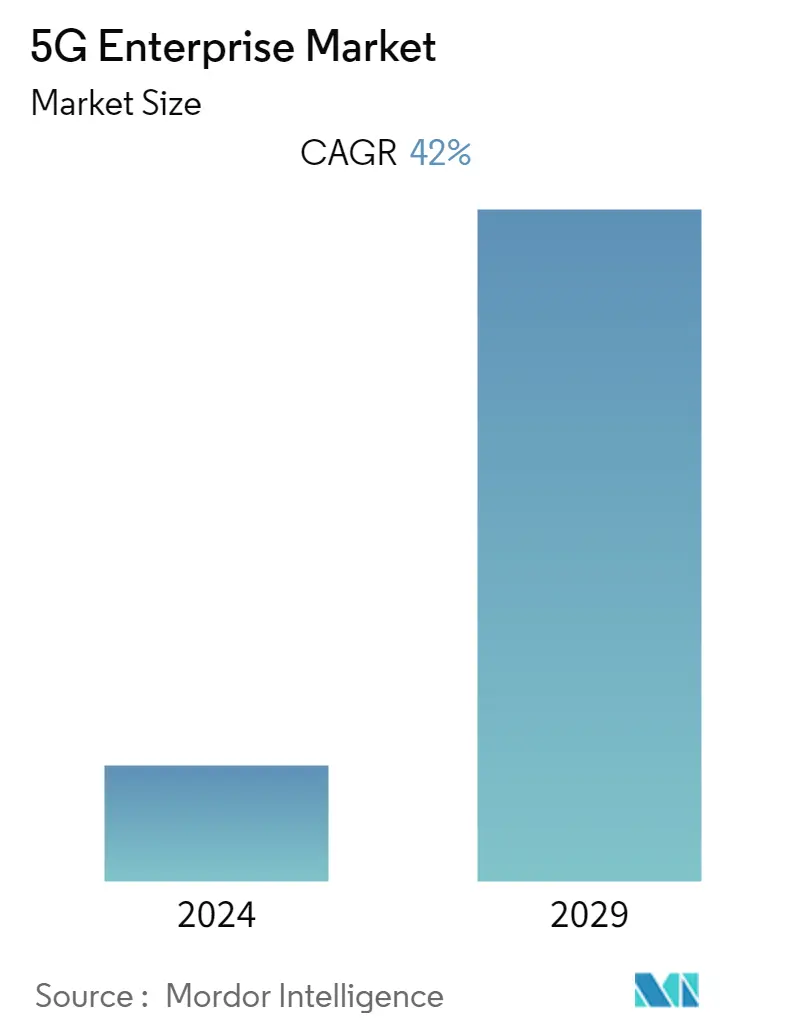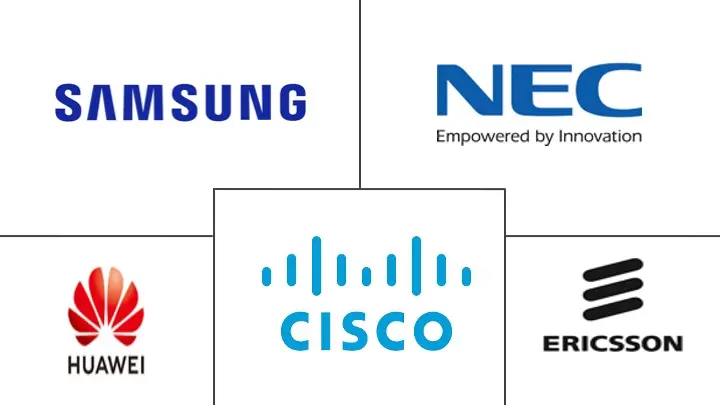Market Size of 5G Enterprise Industry

| Study Period | 2019 - 2029 |
| Base Year For Estimation | 2023 |
| CAGR | 42.00 % |
| Fastest Growing Market | Asia-Pacific |
| Largest Market | North America |
| Market Concentration | Medium |
Major Players
*Disclaimer: Major Players sorted in no particular order |
5G Enterprise Market Analysis
During the time frame of the forecast, the 5G Enterprise Market is expected to register a healthy CAGR of over 42%. The 5G enterprise market is expected to change the way industries that are already moving toward the Industrial Revolution 4.0 connect their devices.Through the rise of IoT and machine-to-machine connections, Industrial Revolution 4.0 is making it easier for cell phones to connect to everything in the industry.
- Connected manufacturing with M2M applications, the IIoT, and robotics, to name a few, would use 5G by making the machines on the assembly line wirelessly connected to the private 5G network.However, the use of wireless for control applications is still at a nascent stage.
- Another significant adoption is expected to be led by offshore oil platforms. These platforms have difficulty providing connectivity by wired means, that is, running a cable from the platform to the shore. Therefore, oil platforms have been tormented with lower speeds and intermittent connectivity for many years.
- Based on Ericsson's 5G for Business 2030 Market Compass, which looked at more than 200 use cases, ten different industries, and a set of 5G-enabled use case clusters, 18% of the total ICT can be used to digitalize industries, and service providers would take up 47% of the 5G-enabled B2B value.
- Multi-access edge computing (MEC) is assisting further developments to enable high-bandwidth, low-latency enterprise applications.Also, both equipment and service providers in the market that was looked at have made their products and services fit a variety of problems.
- For instance, AT&T highlighted mobile 5G, fixed wireless, and edge computing as the three main service pillars of 5G. With its offering of an AT&T Multi-access Edge Compute (MEC), the company facilitates this edge computing solution to deploy a software-defined network. With this, the enterprise clients would have faster access to data processing and flexibility in managing cellular traffic via low-latency, high-bandwidth capabilities.
- Moreover, in April 2022, the Department of Telecommunications (DoT) in India issued an Expression of Interest (EoI) call for the 5G vertical engagement and partnership program (VEPP) initiative, which aims to forge rapid partnerships between the various stakeholders in the 5G ecosystem and address the needs of users and vertical industries.
- Businesses, regional governments, and other groups in the region should have more options for local and private 5G networks if they take these steps.By using the O-RAN open interface, problems caused by proprietary specifications and lack of interoperability may be solved.
- But when COVID-19 broke out, it had an effect on both 5G rollouts and readiness. Some countries put off their spectrum auctions, and a few others put in place rules about how spending should be prioritized.
5G Enterprise Industry Segmentation
5G is expected to make possible many uses that aren't possible with 4G alone, such as better mobile broadband, mission-critical control, and a lot of IoT applications. It should be able to grow and use less energy so that it can keep up with the steady growth of new connections and advanced technologies. As the technology hasn't been fully made available to the public yet, the top companies are learning about its basics.
The 5G enterprise market is segmented by communication infrastructure type (5G radio access networks, 5G core networks, and transport networks), enterprise type (IT and telecom, BFSI, retail and e-commerce, manufacturing, healthcare, consumer goods and retail, and utilities), and geography (North America, Europe, Asia Pacific, Latin America, the Middle East, and Africa).
The market sizes and forecasts are provided in terms of value (USD million) for all the above segments.
| By Communication Infrastructure Type | |
| 5G Radio Access Networks | |
| 5G Core Networks | |
| Transport Networks |
| By Enterprise Type | |
| IT & Telecommunication | |
| BFSI | |
| Retail and Ecommerce | |
| Manufacturing | |
| Other End-user Industries (Healthcare, Consumer Goods and Retail, Utilities, etc.) |
| Geography | |
| North America | |
| Europe | |
| Asia-Pacific | |
| Rest of the World |
5G Enterprise Market Size Summary
The enterprise 5G market is poised for significant transformation, driven by its integration into the Industrial Revolution 4.0 framework. This evolution is facilitated by the proliferation of IoT and machine-to-machine connections, which enhance connectivity across various industrial applications. Industries such as connected manufacturing, IIoT, and robotics are increasingly adopting 5G to enable wireless connections within private networks, although the use of wireless for control applications remains in its early stages. Offshore oil platforms, which have historically struggled with connectivity issues, are expected to benefit significantly from 5G's capabilities. The market is also seeing advancements through multi-access edge computing (MEC), which supports high-bandwidth, low-latency applications, further enhancing the value proposition of 5G for enterprise solutions.
The market landscape is characterized by a competitive environment with key players like AT&T, BT, and Ericsson leading the charge in deploying 5G solutions across various sectors, including manufacturing, healthcare, and transportation. The North American region, in particular, is witnessing a surge in demand for cloud-based enterprise applications, driven by the need for faster internet speeds and advanced technologies such as connected cars and AI. This demand is prompting significant investments in network infrastructure, with operators leveraging technologies like network function virtualization and software-defined networking to optimize performance. The market is also seeing strategic partnerships and innovations, such as Tata Consultancy Services' Enterprise 5G Edge portfolio and the collaboration between Cognizant and Qualcomm Technologies, which aim to enhance digital transformation through 5G-enabled solutions.
5G Enterprise Market Size - Table of Contents
-
1. MARKET INSIGHTS
-
1.1 Market Overview
-
1.2 Industry Attractiveness - Porter's Five Forces Analysis
-
1.2.1 Threat of New Entrants
-
1.2.2 Bargaining Power of Buyers/Consumers
-
1.2.3 Bargaining Power of Suppliers
-
1.2.4 Threat of Substitute Products
-
1.2.5 Intensity of Competitive Rivalry
-
-
1.3 MEC and 5G Industry Analysis (Technical Standards (System Architecture), Applications and Trends)
-
1.4 Assessment of Impact of COVID-19 on the 5G Enterprise Industry
-
-
2. MARKET SEGMENTATION
-
2.1 By Communication Infrastructure Type
-
2.1.1 5G Radio Access Networks
-
2.1.2 5G Core Networks
-
2.1.3 Transport Networks
-
-
2.2 By Enterprise Type
-
2.2.1 IT & Telecommunication
-
2.2.2 BFSI
-
2.2.3 Retail and Ecommerce
-
2.2.4 Manufacturing
-
2.2.5 Other End-user Industries (Healthcare, Consumer Goods and Retail, Utilities, etc.)
-
-
2.3 Geography
-
2.3.1 North America
-
2.3.2 Europe
-
2.3.3 Asia-Pacific
-
2.3.4 Rest of the World
-
-
5G Enterprise Market Size FAQs
What is the current 5G Enterprise Market size?
The 5G Enterprise Market is projected to register a CAGR of 42% during the forecast period (2024-2029)
Who are the key players in 5G Enterprise Market?
Cisco System Inc., Telefonaktiebolaget LM Ericsson, Huawei Technologies Co. Ltd., NEC Corporation and Samsung Group are the major companies operating in the 5G Enterprise Market.

